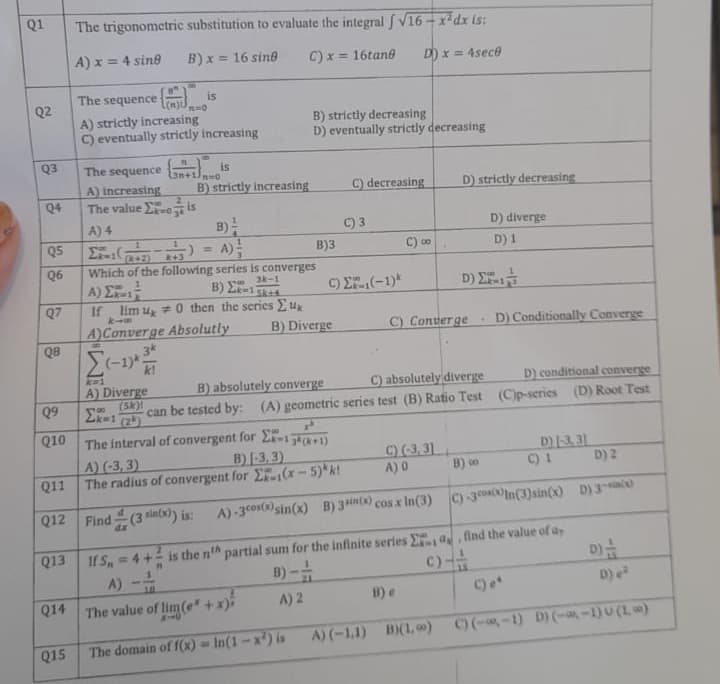Algebra & Trigonometry with Analytic Geometry
13th Edition
ISBN:9781133382119
Author:Swokowski
Publisher:Swokowski
Chapter10: Sequences, Series, And Probability
Section10.4: Mathematical Induction
Problem 46E
Related questions
Question
Q 15 please

Transcribed Image Text:Q1
Q2
Q3
Q4
Q5
Q6
Q7
QB
Q9
Q10
Q11
Q12
The trigonometric substitution to evaluate the integral f√16-x²dx is:
A) x = 4 sing
B)x= 16 sine
C) x = 16tane D) x = 4sece
Q15
The sequence
A) strictly increasing
C) eventually strictly increasing
(
k=1\
A) Diverge
(5k)!
9
100
Ek-1
The sequence is
A) increasing
2
The value Ex=one is
A) 4
1 (24)
is
n=0
L3n+1)=0
B)
Σ=(-) = A)
Which of the following series is converges
Β) ΣΚ-1 5k+4
3k-1
If limu 0 then the series Euk
A)Converge Absolutly
3k
B) strictly increasing
B) strictly decreasing
D) eventually strictly decreasing
B)3
B) Diverge
The interval of convergent for E-1(+1)
14
C) decreasing
C) Σ.,(-1)*
C) 3
A) (-3,3)
B) -3,3)
The radius of convergent for Er(x-5)* kl
Find (3 sin(x)) is:
C) 00
C) (-3,31
A) 0
A)-3cos(x) sin(x) B) 3 sin(x) cos x In(3)
B) absolutely converge
C) absolutely diverge
can be tested by: (A) geometric series test (B) Ratio Test
Q13 If S,=4+ is the nth partial sum for the infinite series
A)
Q14 The value of lim(e*+x)
B)--
A) 2
The domain of f(x)=In(1-x²) is
D) strictly decreasing
D)
C) Converge D) Conditionally Converge
B) e
+
D) diverge
D) 1
#17
D) conditional converge
(C)p-series (D) Root Test
D) -3,31
B) 00
C) 1
D) 2
C)-30) In (3) sin(x) D) 30
, a, find the value of a
()
D)=
D) e²
C) e*
A) (-1,1) B)(1,0) C) (-∞,-1) D) (-1) U (1)
Expert Solution
This question has been solved!
Explore an expertly crafted, step-by-step solution for a thorough understanding of key concepts.
Step by step
Solved in 2 steps with 2 images

Recommended textbooks for you

Algebra & Trigonometry with Analytic Geometry
Algebra
ISBN:
9781133382119
Author:
Swokowski
Publisher:
Cengage

Algebra & Trigonometry with Analytic Geometry
Algebra
ISBN:
9781133382119
Author:
Swokowski
Publisher:
Cengage